Ross Anderson, winner of the Fermor Prize in 2012, searches the Isle of Islay for traces of ~700 million year old life
 Image: Outcrop at Caol Ila.
Image: Outcrop at Caol Ila.
Despite its being early summer, a persistent wind buffeted the Kennacraig-Port Askaig ferry as it made the two-hour crossing from the Scottish mainland along the West Loch Tarbert and out into open sea to Islay. Aboard, carefully studying a geological map while tucking (less carefully) into shepherd’s pie, were Andy Knoll (Harvard University), Ian Fairchild (University of Birmingham), a couple of Ian’s students, and myself. Islay may be famed for its distilleries, but our (principal) goal was not the local tipple. We were visiting because the island is predominantly composed of Neoproterozoic rocks of the Dalradian Supergroup.
SNOWBALL EARTH

Diagram: Geographical map of Islay and generalised stratigraphy of the Dalradian Supergroup and Bonahaven Formation. (From Anderson et al., 2013)
The Neoproterozoic Era (1000-542 Ma) has garnered much interest among geologists and palaeontologists alike. It represents an interval of environmental upheaval during which the Earth endured several geographically widespread glaciations, the ‘Snowball Earth’ events, accompanied by pronounced carbon-cycle variation. These environmental changes provide a remarkable climatic backdrop to an interval in which the Earth moved from being a ‘bacterial world’ to one containing large and diverse animals. Indeed the first fossilised animals appear toward the very end of the Era.
Yet other members of our domain, the Eukaryota, have a deeper fossil record which stretches back to the beginning of the Proterozoic Eon and perhaps even further. Palaeontologists have worked throughout the past two decades to assemble a diverse record of eukaryotic fossils from Neoproterozoic rocks worldwide. However, the rocks of Islay have contributed little to this story. Surprisingly, despite recording a significant portion of Neoproterozoic time in extensive exposures, no confirmed eukaryotic fossils have ever been reported from the Scottish Dalradian Supergroup. Perhaps if eukaryote fossils existed, they were erased by metamorphism. Or maybe, the fossils are present - hiding from view.
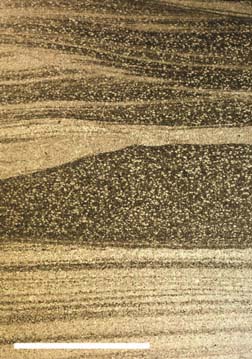 Image: Flat bed scan of thin-section showing spherule bearing mudstone horizons interbedded with sandstone horizons. Scale bar is 10 mm. (From Anderson et al., 2013).
Image: Flat bed scan of thin-section showing spherule bearing mudstone horizons interbedded with sandstone horizons. Scale bar is 10 mm. (From Anderson et al., 2013).
Several months earlier I had contacted Ian as, being originally from England, I hoped to start a project in Britain for my undergraduate thesis at Harvard. Ian pointed me to a journal article he wrote in 1977 for Geological Magazine in which he documented enigmatic spherules, c. 100µm in diameter, from Dalradian mudstones on Islay. These, he suggested, recorded eukaryotic microfossil walls that had been filled penecontemporaneously with glauconite, later transformed to phengite.
The evidence Ian marshalled for this interpretation included the observations that the spherules had a restricted size distribution, consistent with a biological origin; they were collapsed next to desiccated margins, suggesting they were hollow prior to sedimentation, and possessed internal petrological features that demonstrated an early mineral fill. While this hypothesis was plausible, Ian had not considered a range of other physical methods for their origination. These included spherules associated with extraterrestrial impacts, and potential microstructures associated with metamorphism.
It was to re-explore these spherule structures and to discover the true story of their origin that brought us to Islay. If Ian was correct, the spherules that he discovered over 30 years ago could potentially provide an important and hitherto unappreciated record of Neoproterozoic eukaryotes.
DALRADIAN
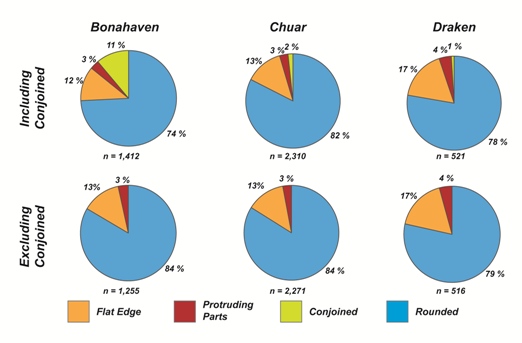 Image: Results of morphological shape comparison of spherules. (From Anderson et al., 2013).
Image: Results of morphological shape comparison of spherules. (From Anderson et al., 2013).
The rocks that make up Islay form part of the Dalradian Supergroup, which stretches across the highlands striking north-eastward. The succession contains lithologically diverse sedimentary rocks that have been metamorphosed to varying degrees. The basin’s formational history is dominated by extensional tectonics. However, there is currently little consensus regarding its specific tectonic evolution. Uranium-lead geochronology of monazite in basement rocks constrains a maximum age of 806 ± 3 Ma, while a zircon age of 601 ± 4 Ma lies close to its top, suggesting the Supergroup spans some ~200 million years of Earth history. The Supergroup can be divided into four Groups of which the most interesting for our purposes is the Argyll Group. This is exposed on Islay and includes the Bonahaven Formation, where Ian originally found the spherule structures, as well as records of two Neoproterozoic glaciations.
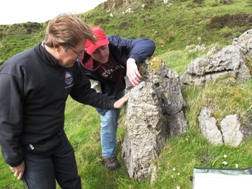 Image: Andy Knoll (left) and Ross Anderson (right) discuss Neoproterozoic rocks on Islay (Courtesy I. J. Fairchild).
Image: Andy Knoll (left) and Ross Anderson (right) discuss Neoproterozoic rocks on Islay (Courtesy I. J. Fairchild).
The ferry docked at the small village of Port Askaig on Islay’s north-east coast. We drove our Land Rover out of the port and village and climbed the snaking path to the cliff top. The road-cut sliced through a glacial diamictite, the Port Askaig Tillite. This dramatic deposit lies near to the base of the Argyll Group and can be correlated to the first of two globally described Neoproterozoic glaciations (Sturtian) based on characteristic carbon and strontium isotope signatures in carbonates below the Tillite.
A recent Re-Os age for a formation that lies stratigraphically below the Tillite (from Alan Rooney and colleagues at the University of Durham) calls into question this interpretation and suggests that the Tillite actually correlates with the second large Neoproterozoic glaciation (Marinoan). Whichever interpretation is correct, the spherule structures are found in rocks of the Bonahaven Formation which lie directly on top of the Port Askaig Tillite and so are at least younger than the Sturtian glaciation.
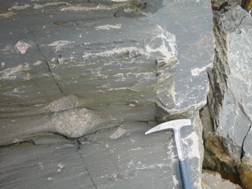 Image right: Glacial dropstone in the Port Askaig Tillite.
Image right: Glacial dropstone in the Port Askaig Tillite.
We concentrated our efforts to the north and east of Port Askaig, in the coastal villages of Bunnahabhain and Caol Ila (both – coincidentally - famed for their whisky). It is close to these two villages where you can find the top of member 1 of the Bonahaven Formation, exposed in 4-6m thick outcrops by the shore. Sedimentary structures, including cross-bedding and desiccation cracks, have been used to suggest these rocks were deposited in a tidal flat environment subject to frequent sub-aerial exposure. At both localities we described the stratigraphy, noting centimetre-scale interlaminations of dark carbonaceous mudstones with fine to medium-grained sandstones that occasionally possess dolomitic cements. The degree of regional metamorphism is greenschist facies (biotite-grade), however the rocks at these localities display no discernable metamorphic textures.
DARK MATERIALS
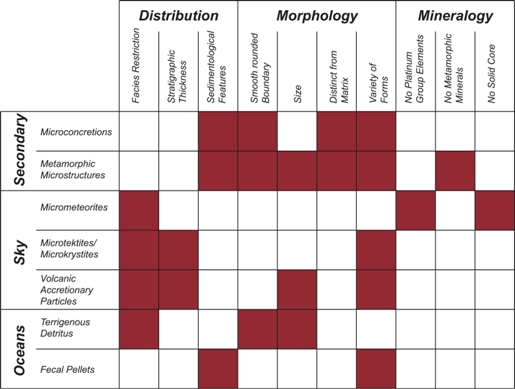 Image: Chart depicting lines of evidence upon which physical origins were rejected. (From Anderson et al., 2013).
Image: Chart depicting lines of evidence upon which physical origins were rejected. (From Anderson et al., 2013).
So what are the distinguishing features of Fairchild’s enigmatic spherules? Their size meant they were only visible in polished hand specimen. Consequently, we took samples throughout the two stratigraphic sections but had to wait with trepidation to describe our haul until we had returned to the laboratories of Harvard and Birmingham. There we made petrographic thin-sections, which revealed abundant spherules distributed throughout the top ~4 m of member 1 of the Bonahaven Formation, but confined only to mud laminae. We observed clay minerals both inside and outside the spherules, yet were still able to distinguish the spherule interiors by an absence of dark materials that colour the matrix, and by their smoothly rounded boundaries.
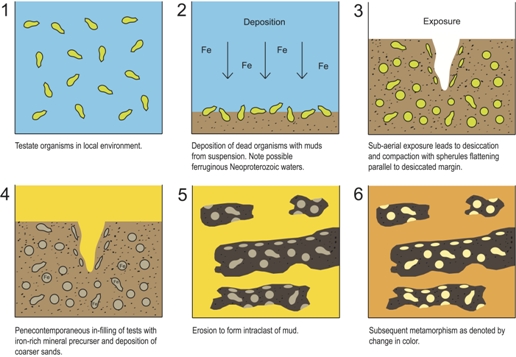 Image: Stages of proposed origination of spherules.
Image: Stages of proposed origination of spherules.
The contrast in abundance of dark material between spherule interiors and the matrix suggested to us that external sediment was not simply forced into them. In thin-section the spherules generally appear circular to ovoid with a maximum dimension of ~120-160µm. However we observed some that differ from this morphology, either exhibiting a flat surface at the tapering end of their long axis, or an irregularly shaped neck-like structure that protrudes into the matrix. One can also find ‘conjoined’ spherules. X-Ray Diffraction analysis (conducted by Nick Tosca at St Andrews) showed that the spherule-bearing mudstones are predominantly composed of muscovite, probably a metamorphic product of an earlier smectite mineral. The analyses also highlighted the presence of minor quantities of iron-bearing minerals. One may not be surprised to discover such iron enrichments, given that increasing analyses show evidence for iron-rich water masses in later Neoproterozoic oceans.
Once descriptions of the spherules were made it was time to attempt to answer the question in hand: what exactly were the spherical structures and how did they originate? We decided to answer this question by considering different potential origins, and what distinguishing features each would predict for spherule morphology, mineralogy and stratigraphic distribution. The presence or absence of these features could then be tested through observations, thus providing evidence for or against a given origin. After completing this process, I now believe that all potential physico-chemical mechanisms can be rejected, based on a combination of distributional, morphological, and compositional evidence. For the purposes of this article, I will highlight only the reasons we gave for rejecting two of the most likely candidate hypotheses – namely, microtektites/microkrystites and metamorphic microstructures.
SHOWERS OF GLASS
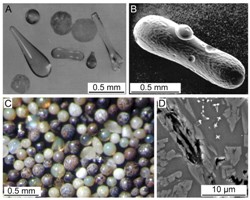 Image: Various Cenozoic microtektites showing varying morphologies (From Glass and Simonson, 2012).
Image: Various Cenozoic microtektites showing varying morphologies (From Glass and Simonson, 2012).
Microtektites/microkrystites, made famous by their association with the Cretaceous-Palaeogene boundary impact hypothesis, have been described from many horizons - some as old as Archean. Microtektites/microkrystites are glass particles that form from the splash debris of a meteorite impact. Their varied morphologies include elongate, spherical, spindle, and dumbbell forms. Size varies as a function of distance from the impact but can reach up to 0.2-0.5 mm in maximum dimension.
Microtektites/microkrystites tend to be found confined to narrow seams (at the most a few centimetres thick), as befits an impact-event deposit. Bruce Simonson among others has shown that sedimentary processes can rework these deposits and redistribute the spherules throughout several metres of stratigraphy. The microtektite/microkrystite hypothesis, therefore, could provide a plausible explanation for the Bonahaven spherules: microtektites/microkrystites can be of similar size, display the forms we see, and even be distributed throughout several metres of section.
However, here lies the crucial distinction. While the Bonahaven spherules appear in several metres of stratigraphy they are confined only to mudstone facies. Consequently if the spherules were reworked they must have had a mass closer to the clay minerals that form the mudstones than the quartz grains found in interlaminated sandstones. Thus, given their size, these structures could not have been composed of silicate minerals. So, we concluded, microtektites/microkrystites could not account for the Bonahaven spherules.
SPOTS & CLOTS
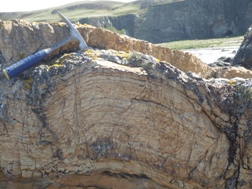 Image: Stromatolite in Neoproterozoic rocks of Islay.
Image: Stromatolite in Neoproterozoic rocks of Islay.
Another possible origination hypothesis is as metamorphic microstructures. Rocks on Islay have been metamorphosed. During contact metamorphism, spots/clots can from within rocks. These tend to be quite large (on a millimetre scale) and are composed mostly of muscovite and chlorite aggregates, with a colour gradation from interior to exterior. Metamorphic spots also have a distinctive texture, being indistinct from the matrix, superimposing themselves upon the original fabric of the rock with an irregular boundary. The Bonahaven spherules fail to exhibit any of these characteristics, being smaller, having no colour gradation, and being distinct from the matrix with a smoothly rounded boundary. Other metamorphic microstructures include biotite clots, yet these can be eliminated too by the absence of appreciable biotite in the rocks. All other physical modes of origination such as detrital grains, micrometeorites, volcanic accretionary particles, and microconcretions can also be eliminated by similar reasoning. Therefore invoking the Sherlock Holmesian dictum: “Whatever remains, however improbable, must be the truth”, we were brought back to the idea of a Neoproterozoic biological origin for the Bonahaven spherules.
Most Neoproterozoic microfossils have mechanically weak organic walls that collapse during burial, leaving essentially two-dimensional compressions. One group of microfossils known to preserve as three dimensional structures infilled with diagenetic minerals are vase-shaped microfossils (VSMs), generally interpreted as the remains of testate amoebozoans and, perhaps, rhizarians. VSMs were first discovered in 1933 but were only identified as having affinity for modern testate amoebae in 2000 by Susannah Porter and Andy Knoll, who used the fact that these organisms are heterotrophs to argue for ecological complexity in the Neoproterozoic.
The fossils are quite common in ca. 800-740 Ma rocks, where they can be found as mineralised casts and moulds of the amoebas’ organic walled tests. Often the organic wall itself is lost during fossilisation. Were therefore the Bonahaven Spherules VSMs? A defining feature of VSMs is their morphology of cup-shaped to tear-shaped tests, with a single oral opening. Evidence suggests that the Bonahaven spherules possess rounded surfaces with truncated ends, similar to this oral aperture. They also have a size frequency distribution like many biological populations, all of which supports a conclusion that the record of eukaryotic life represents testate amoebae similar to those found in other rocks from this period of Earth history.
SPIRIT OF INQUIRY
Our trip to this remote Scottish island has revealed the fossilised remnants of some of the oldest eukaryotes in Britain, hidden among the island’s many coastal cliffs and distilleries. However the microfossils discovered in Scotland are not just another microfossil record to add to a global bucket list. They have particular importance, thanks to their stratigraphic context.
Casting your mind back to the introduction, you may recall that the Bonahaven Formation is younger than the first of the global Neoproterozic glaciations (the Sturtian). VSMs of the type similar to the Bonahaven spherules were previously known only from rocks older than this glaciation. Consequently, the Bonhaven spherules provide evidence that some pre-Sturtian eukaryotes survived into post-Sturtian oceans. The time interval between the two glaciations has so far proved a poor hunting ground for Precambrian fossils.
However, these discoveries add to a growing list made over the past few years by Tanja Bosak and colleagues at MIT, who have shown that fossils do exist in inter-glacial rocks. Clearly we need now to work hard, populating this hitherto barren interval, if we are ever to understand the role of eukaryotic organisms in the post-glacial world. The microfossils of Scotland though have already made a contribution to this story.
COMPLEXITIES
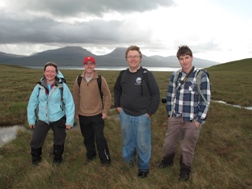 Image: (Left to right) Emily Macmillan, Ross Anderson, Andy Knoll, and Edward Fleming (Courtesy I. J. Fairchild).
Image: (Left to right) Emily Macmillan, Ross Anderson, Andy Knoll, and Edward Fleming (Courtesy I. J. Fairchild).
For me personally, the Islay trip provided me with experience of doing science, rather than just reading about it. At Harvard, I had always read and been told of the complexities of Precambrian research; but it was not until I started this work that I truly appreciated them. Never were these challenges more evident than in our attempts to decipher the three-dimensional morphology of the spherules. The ~700 million years of Earth history that have passed since the rocks’ formation had taken its toll, subjecting them to episodes of metamorphism that had resulted in the rocks mineralogical homogenisation - the spherules were no longer mineralogically distinct from the matrix rock. Consequently, we could not separate the spherules from the rock, which challenged our ability to reconstruct them in three dimensions. More innovative techniques were required to solve the problem, such as comparing the distribution of morphologies in various orientations of transverse section. The complexities were not just confined to this instance: in general the conclusions we made required an array of techniques to build a coherent picture of the spherules’ origin.
This multidisciplinary approach, combining field, petrographic, and geochemical observations, while time consuming, provides the best chance of enhancing our knowledge of the murkier intervals of Earth history.
* Current address: Department of Geology and Geophysics, Yale University, 210 Whitney Avenue, New Haven, CT, 06511, USA. Address while completing work: Department of Earth and Planetary Sciences, Harvard University, 20 Oxford Street, Cambridge, MA, 02138, USA. E: ross.anderson@yale.edu.
More detail
Anderson, R P, Fairchild, I J, Tosca, N J, Knoll, A H, 2013. Microstructures in metasedimentary rocks from the Neoproterozoic Bonahaven Formation, Scotland: Microconcretions, impact spherules, or microfossils? Precambrian Research 233, 59-72. available online 26 April 2013. A list of suggested further reading may be found below. Editor.
Acknowledgments
The author wishes to thank the Editor and the Geological Society for inviting him to write this feature, and the Fermor Fund for generously supporting his attendance at the Fermor Meeting, September 2012. The work described was performed in collaboration with Ian J Fairchild (University of Birmingham), Nicholas J Tosca (University of St Andrews), and Andrew H Knoll (Harvard University) to all of whom the author is indebted for their generous advice and guidance throughout. Thanks also to David Johnston, Daniel Lahr, and Bruce Simonson for constructive comments and insights into the realms of geochemistry, modern testate microorganisms, and impact spherules, respectively; also Phoebe Cohen, Emily Macmillan, and Edward Fleming for assistance in lab and field. Work supported by the NASA Astrobiology Institute, the Harvard Origins of Life Initiative 2011 Summer Undergraduate Research Fellowship, and the Department of Earth and Planetary Sciences, Harvard University. It was performed in part at the Center for Nanoscale Systems (CNS), a member of the National Nanotechnology Infrastructure Network (NNIN), supported by the National Science Foundation under NSF award no. ECS-0335765. CNS is part of Harvard University.
SUGGESTED FURTHER READING
- Bosak, T., Lahr, D.J.G., Pruss, S.B., Macdonald, F.A., Dalton, L., Matys, E., 2011. Agglutinated Tests in Post-Sturtian Cap Carbonates of Namibia and Mongolia. Earth and Planetary Science Letters 308, 29-40.
- Bosak, T., Lahr, D.J.G., Pruss, S.B., Macdonald, F.A., Gooday, A.J., Dalton, L., Matys, E.D., 2012. Possible Early Foraminiferans in Post-Sturtian (716-635 Ma) Cap Carbonates. Geology 40, 67-70.
- Brasier, M.D., Shields, G., 2000. Neoproterozoic Chemostratigraphy and Correlation of the Port Askaig Glaciation, Dalradian Supergroup of Scotland. J. Geol. Soc. 157, 909-914.
- Canfield, D.E., Poulton, S.W., Knoll, A.H., Narbonne, G.M., Ross, G., Goldberg, T., Strauss, H., 2008. Ferruginous Conditions Dominated Later Neoproterozoic Deep-Water Chemistry. Science 321, 949-952.
- Cruz, M.D.R., Galan, E., 2002. Mineralogy and Origin of Spots in Spotted Slate from the Malaguide Complex, Betic Cordilleras, Spain: An XRD, EMPA and TEM-AEM Study. Canadian Mineralogist 40, 1483-1503.
- Fairchild, I.J., 1977. Phengite Spherules from Dalradian Bonahaven Formation, Islay, Scotland - Glauconitized Microfossils. Geological Magazine 114, 355-&.
- Fairchild, I.J., 1985. Petrography and Carbonate Chemistry of Some Dalradian Dolomitic Metasediments - Preservation of Diagenetic Textures. J. Geol. Soc. 142, 167-185.
- Fairchild, I.J., 1991. Itinerary Ii: Topmost Islay Limestone (Appin Group), Port Askaig and Bonahaven Formations (Argyll Group) Port Askaig Area, Islay, in: Hambrey, M.J., Fairchild, I.J., Glover, B.W., Stewart, A.D., Treagus, J.E., Winchester, J.A. (Eds.), Geologists's Assocation Guide No. 44: The Late Precambrian Geology of the Scottish Highlands and Islands. The Geologists' Association, London.
- Glass, B.P., Simonson, B.M., 2012. Distal Impact Ejecta Layers: Spherules and More. Elements 8, 43-48.
- Hoffman, P.F., Kaufman, A.J., Halverson, G.P., Schrag, D.P., 1998. A Neoproterozoic Snowball Earth. Science 281, 1342-1346.
- Johnston, D.T., Poulton, S.W., Dehler, C., Porter, S., Husson, J., Canfield, D.E., Knoll, A.H., 2010. An Emerging Picture of Neoproterozoic Ocean Chemistry: Insights from the Chuar Group, Grand Canyon, USA. Earth and Planetary Science Letters 290, 64-73.
- Knoll, A.H., 2003. Life on a Young Planet: The First Three Billion Years of Evolution on Earth. Princeton University Press, Princeton.
- Knoll, A.H., Javaux, E.J., Hewitt, D., Cohen, P., 2006. Eukaryotic Organisms in Proterozoic Oceans. Philosophical Transactions of the Royal Society B-Biological Sciences 361, 1023-1038.
- Macdonald, F.A., Schmitz, M.D., Crowley, J.L., Roots, C.F., Jones, D.S., Maloof, A.C., Strauss, J.V., Cohen, P.A., Johnston, D.T., Schrag, D.P., 2010. Calibrating the Cryogenian. Science 327, 1241-1243.
- Porter, S.M., Knoll, A.H., 2000. Testate Amoebae in the Neoproterozoic Era: Evidence from Vase-Shaped Microfossils in the Chuar Group, Grand Canyon. Paleobiology 26, 360-385.
- Porter, S.M., Meisterfeld, R., Knoll, A.H., 2003. Vase-Shaped Microfossils from the Neoproterozoic Chuar Group, Grand Canyon: A Classification Guided by Modern Testate Amoebae. Journal of Paleontology 77, 409-429.
- Rooney, A.D., Chew, D.M., Selby, D., 2011. Re-Os Geochronology of the Neoproterozoic-Cambrian Dalradian Supergroup of Scotland and Ireland: Implications for Neoproterozoic Stratigraphy, Glaciations and Re-Os Systematics. Precambrian Research 185, 202-214.
- Spencer, A.M., 1971. Late Pre-Cambrian Glaciation in Scotland. The Geological Society, London, Memoirs, 6.